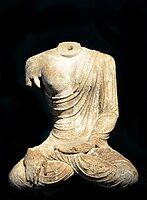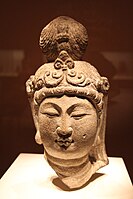Tianlongshan Grottoes
Artwork
A number of works of Buddhist sculpture survived in the caves, including over 1,500 statues and 1,144 reliefs sculptures. Many of the sculptures are of painted stone. The subject matter includes images of Buddha and bodhisattvas. The caves' Tang sculptures are noted for their soft modeling, sensuous drapery, and naturalism. A connection to the Gandhara style of Buddhist sculpture has been proposed.
Similarities with Central Asian Buddhist styles
The Buddhist art of Central Asia, particularly the area of Afghanistan, in the 7th-8th century CE shows a phase using "Sinicized Indian models". During this period, the Chinese Tang Empire extended its influence and promotion of Buddhism to the Kingdom of Central Asia, with a corresponding influx of Chinese monks, while there was conversely a migration of Indian monks from India to Central Asia, precisely looking for this protection. These events gave rise to the hybrid styles of Fondukistan and of the second artistic phase of Tapa Sardar in Afghanistan. This style is part of a cosmopolitan artistic idiom which spread from China to Central Asia at the time, with similarities visible for example in the Tang productions of Tianlongshan.
Removal of the sculptures
In the 1920s, a number of the sculptures were removed and sold to collectors abroad. In particular, the publication by Japanese art dealer Yamanaka Sadajirō of a book on the caves' contents led to a sharp increase in collector interest. For this reason, many sculptures originating from Tianlongshan are currently housed in foreign museums.
Sculpture digitization
The Tianlongshan Grottoes exist today in a damaged state in Taiyuan with so many of the sculptures now missing, that visitors to the caves cannot imagine how they looked in the past. Many of the sculptures from the caves are now in museums around the world. Researchers at the University of Chicago initiated the Tianlongshan Caves Project in 2013 to pursue research and digital imaging of the caves and their sculptures. The Project seeks to record and archive the sculptures and to compile data that can identify the fragments and their places of origin.
Gallery
-
Torso of a sitting Buddha
-
Sitting bodhisattva
-
Standing bodhisattva
-
Tang Bodhisattva Head, Tianlongshan
See also
References
- ^ "Tianlongshan Grottoes, Taiyuan". Your Gateway Travel to Beijing, China. Retrieved 23 August 2015.
- ^ "Tianlong Shan Cave Temples, Shanxi, China". Encyclopædia Britannica. Retrieved 23 August 2015.
- ^ Falco, Angela (2006). Chinese Sculpture. Yale University Press. p. 309. ISBN 0300100655.
- ^ "Stylistic similarities between the images of Fonduqistan and late Tapa Sardar and the early 8th-century Tang production of Tianlongshan have been noted, and the existence of a 'common international style' inclusive of Tang China and the regions to the west and south of the Pamir has been suggested" in Verardi, Giovanni; Paparatti, Elio (2005). "From Early to Late Tapa Sardār: A Tentative Chronology". East and West. 55 (1/4): 433. ISSN 0012-8376. JSTOR 29757657.
- ^ Verardi, Giovanni; Paparatti, Elio (2005). "From Early to Late Tapa Sardār: A Tentative Chronology". East and West. 55 (1/4): 437–438. ISSN 0012-8376. JSTOR 29757657.
- ^ Rösch, Petra (2007). Chinese Wood Sculptures of the 11th to 13th centuries: Images of Water-moon Guanyin in Northern Chinese Temples and Western Collections. New York City: Columbia University Press. p. 210. ISBN 978-3838256627.
- ^ "Center for the Art of East Asia in the Department of Art History at the University of Chicago".



